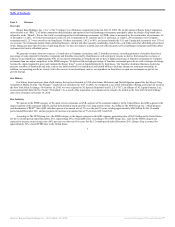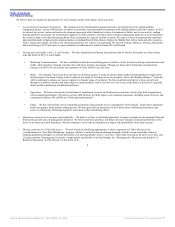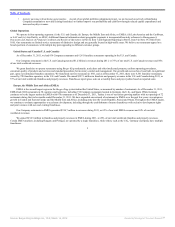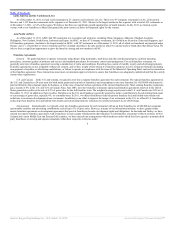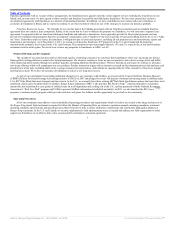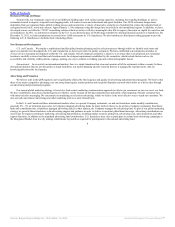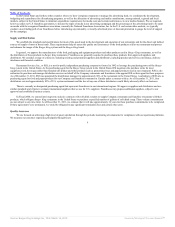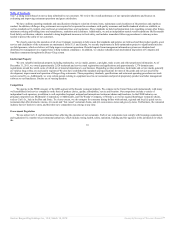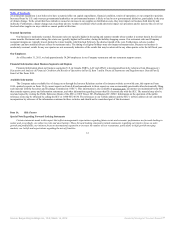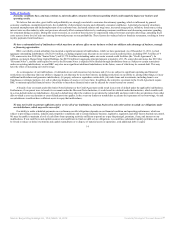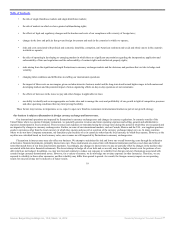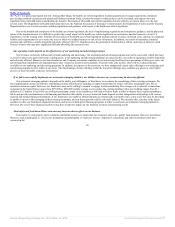Burger King 2011 Annual Report Download - page 14
Download and view the complete annual report
Please find page 14 of the 2011 Burger King annual report below. You can navigate through the pages in the report by either clicking on the pages listed below, or by using the keyword search tool below to find specific information within the annual report.
Table of Contents
restaurants and Company restaurants, including our expectations that the percentage of franchise restaurants will increase; our beliefs and expectations
regarding our ability to drive sales and traffic in the U.S and Canada through execution of our four priorities of marketing communications, menu, operations
and image; our beliefs and expectations regarding the strength of our menu and our ability to optimize our menu by focusing on core products while continuing
to enhance our menu to appeal to a broader range of consumers; our expectations regarding opportunities to enhance restaurant-level margins and profitability;
our beliefs and expectations regarding our ability to drive corporate-level G&A efficiencies; our beliefs and expectations regarding our ability to actively pursue
refranchising opportunities to improve our profitability and cash flow; our ability to manage fluctuations in foreign currency exchange and interest rates; our
estimates regarding our liquidity, capital expenditures and sources of both, and our ability to fund future operations and obligations; our estimates regarding the
fulfillment of certain volume purchase commitments; our expectations regarding the impact of accounting pronouncements; our intention to renew hedging
contracts; and our expectations regarding unrecognized tax benefits. These forward-looking statements are only predictions based on our current expectations
and projections about future events. Important factors could cause our actual results, level of activity, performance or achievements to differ materially from
those expressed or implied by these forward-looking statements, including, but not limited to, the risks and uncertainties discussed below.
Risks related to our business
Our success depends on our ability to compete with our major competitors, many of which have greater resources than us.
The restaurant industry is intensely competitive and we compete in the United States and internationally with many well-established food service
companies on the basis of product choice, quality, affordability, service and location. Our competitors include a variety of independent local operators, in
addition to well-capitalized regional, national and international restaurant chains and franchises. In the FFHR industry our principal competitors are McDonald’s
and Wendy’s as well as regional hamburger restaurant chains, such as Carl’s Jr., Jack in the Box and Sonic. To a lesser extent, we also compete for consumer
dining dollars with national, regional and local (i) quick service restaurants that offer alternative menus, (ii) casual and “fast casual” restaurant chains, and
(iii) convenience stores and grocery stores. Furthermore, the restaurant industry has few barriers to entry, and therefore new competitors may emerge at any time.
Our ability to compete will depend on the success of our plans to improve existing products, to develop and roll-out new products and product line
extensions, to effectively respond to consumer preferences and to manage the complexity of our restaurant operations as well as the impact of our competitors’
actions. Some of our competitors have substantially greater financial resources, higher revenues and greater economies of scale than we do. These advantages
may allow them to (1) react to changes in pricing, marketing and the QSR segment in general more quickly and more effectively than we can, (2) rapidly expand
new product introductions, (3) spend significantly more on advertising, marketing and other promotional activities than we do, which may give them a
competitive advantage through higher levels of brand awareness among consumers and (4) devote greater resources to accelerate their restaurant remodeling and
rebuilding efforts. Moreover, certain of our major competitors have completed the reimaging of a significant percentage of their store base. These competitive
advantages arising from greater financial resources and economies of scale may be exacerbated in a difficult economy, thereby permitting our competitors to gain
market share. Such competition may adversely affect our revenues and profits by reducing revenues of Company restaurants and royalty payments from franchise
restaurants.
The market for retail real estate is highly competitive. Based on their size advantage and/or their greater financial resources, some of our competitors may
have the ability to negotiate more favorable ground lease terms than we can and some landlords and developers may offer priority or grant exclusivity to some of
our competitors for desirable locations. As a result, we may not be able to obtain new leases or renew existing leases on acceptable terms, if at all, which could
adversely affect our sales and brand-building initiatives.
13
Source: Burger King Holdings Inc, 10-K, March 14, 2012 Powered by Morningstar® Document Research℠


